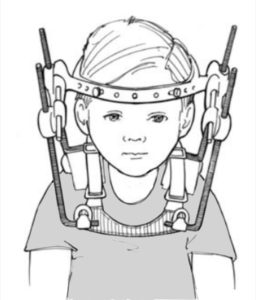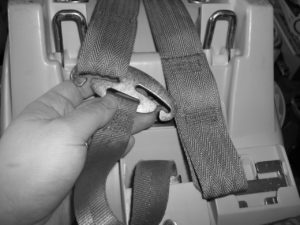
Halo traction is used to hold the head in place and stabilize the cervical spine after surgery or injury. It is comprised of a metal framework (called a halo, due to the fact that it encircles the head) attached by pins to the patient’s skull and connected to the body using straps or a vest. The device allows children to move around and participate in many regular activities during the weeks or months of recovery. Although helpful tips for caregivers of children using a halo can be found online, very little is said about safely transporting these children.
Therefore, spurred by an inquiry on the CPSforHealthcare listserv from Julie Philbrook, CPST-I and nurse in Minnesota, SRN began to research the following detailed guidance for CPSTs and families facing this situation. Special thanks to Adrienne Gallardo and Michelle Nichols of Doernbecher Children’s Hospital in Portland, Oregon, for the assistance and expertise they contributed. Further assistance is available for CPSTs by contacting the Automotive Safety Program at Riley Hospital for Children.
General Challenges Presented by Halos
Little is known about the effect of a halo (also called a halo vest, ring, or brace) on crash dynamics. However, it stands to reason that children in halos should follow CPS best practices as closely as possible, including properly using a CR in the mode that is most appropriate for the child’s size/age.

A halo poses the following challenges:
- Since a halo is affixed to a child’s skull and sticks out from the head, a CR must provide ample space in the head area.
- A halo makes it very difficult to position a harness over a child’s shoulders since the straps must route within its framework. This limits CR options to models with straps that can be temporarily detached from a splitter plate (the metal part at the back of a CR where the two harness straps join the adjuster strap, shown in the image to the right).
- A halo may weigh as much as 7 pounds, weight which must be added to the child weight when complying with CR weight limits. Also account for the combined weight when considering the caregiver’s ability to gently lift a child into the CR.
- Many children using halo traction have additional conditions that must also be taken into account.
Guidance for RF Children
Rear-facing mode is heavily favored for a child wearing a halo. The child’s head and neck, which are more fragile than those of other children, are better off cradled by the CR (rather than thrown forward by crash forces). Therefore, RF mode is recommended whenever possible. Look for a CR model with a high RF weight limit; follow weight limits by adding the weight of the halo to the child’s weight, and take into account that the child may get heavier during treatment.
In addition, when a halo is present, a caregiver must detach/reattach each harness strap at the splitter plate in order to bring it to the front of the CR to thread within the halo framework. This painstaking process is the only way to get the harness to make proper contact with the child’s shoulders. Since the CR selected must allow the shoulder straps to detach from the splitter plate, many models with a no-rethread harness are not suitable. The procedure is easiest when the CR is rear facing since reaching the splitter plate doesn’t necessitate uninstalling the CR.
Use a RF convertible or all-in-one model; RF-only CR models are too limited in the head area for a child wearing a halo. Be sure the shell of the CR is wide enough for the halo and provides enough clearance above the head (including during loading). Also, the sides must not be so high that the caregiver is unable to lift the child into the CR.
Guidance for FF Children
A child who does not have the option to ride rear facing must ride forward facing in a CR with a harness, a booster, or a modified vest.
If the child is too small and/or young for a booster, a CR with a harness must be used. Look for one that has all the same characteristics as the rear-facing CR described above. However, additional CR characteristics are needed when forward facing because the splitter plate is inaccessible when a CR is installed FF, so a caregiver must be able to uninstall and reinstall the CR each time the harness is rethreaded through the halo frame.
Therefore, consider only CR models that can be installed while the child is seated. This requirement disqualifies many models with modern installation features that are typically a plus for ease of use, such as belt-tensioning plates and certain types of lock-offs under the seat pad. Also, avoid any model that requires a serpentine belt path.
Instead, look for a CR with a wide-open belt path, perhaps with a lock-off on the side of the CR. In some cases, it may be advisable to place a locking clip on the belt webbing so that the caregiver can simply rebuckle the belt at a preset tightness. If the child does not weigh too much and using the LA attachment is an option, a system with a tilt-lock adjuster and/or connectors that have a push-button or pull-strap release mechanism is recommended, so that detachment from and reattachment to the LA bar is easy. (In general, remind caregivers that up to an inch of movement is acceptable; getting a “rock-solid” installation is probably unrealistic in this situation.)
It’s always advisable to tether a forward-facing CR, especially when the occupant is wearing a halo. However, because the back of the CR must be accessed each time the harness is fastened and unfastened, a tether must be detached (or, at least, loosened) for each use, as well.
As all this suggests, use of a forward-facing CR for children in a halo can be tedious, time-consuming, and physically challenging. Therefore, a booster may be an appealing alternative for larger children, especially if the caregiver is unable to carry out the required steps for forward-facing CR use. Since most highback boosters are too narrow in the head area, using a backless model in a vehicle seating position with a properly positioned head restraint is recommended.
However, even when using a seat belt with a booster (or a seat belt alone), the shoulder belt should ideally be threaded within the halo framework to contact the child’s shoulder. Therefore, a seat belt with a dual-latchplate design (like those described in depth in SRN’s March/April 2019 issue) is essential. With this type of belt, which is sometimes found in a vehicle’s center rear seating position, both hip anchor points can be unbuckled, so the webbing can be threaded properly through the halo framework to fit against the child’s body before rebuckling at the hips.
For older children (at least age 1 and 22 pounds) who must ride lying down, an EZ-On Modified Lay Down Vest may be used. However, to use the vest properly, its shoulder attachments must be entirely unthreaded (opened) for each use so that the straps can be placed over the child’s shoulders. (Note: Using an EZ-On vest model that allows the child to sit up, while technically an option, is not ideal since donning the vest is difficult, and attaching the tether strap to its shoulders is usually complicated by the halo.)
Expert advice for CPSTs
Regardless of the CR, it’s best to transport a child with a halo as infrequently as possible. Gallardo and Nichols of Doernbecher Children’s Hospital stated that Evenflo Titan and Diono Radian models tend to work well for their program. Says Gallardo, “It has been my experience that it’s important for the CPST to work patiently, calmly, and in partnership with the caregiver. It is a scary time for families, and they look to us as professionals.”
